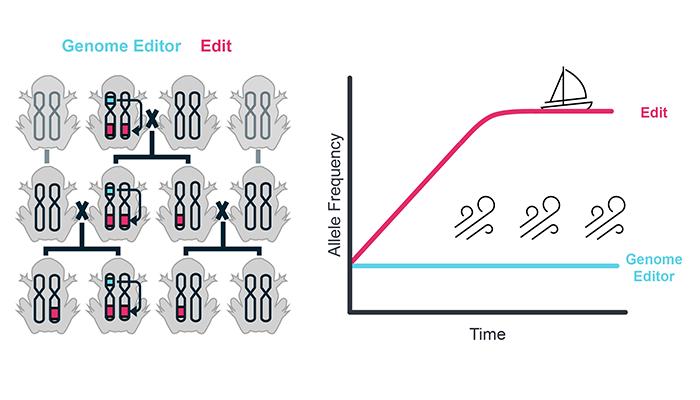A new technique developed by researchers from Macquarie University and the California Institute of Technology published in Nature Communications on 13 August could allow scientists to more safely alter the genetic makeup of wild populations.

Credit: Maciej Maselko
A new technique developed by researchers from Macquarie University and the California Institute of Technology published in Nature Communications on 13 August could allow scientists to more safely alter the genetic makeup of wild populations.
The researchers have proposed a new technique that aims to address some of the regulatory challenges and public concerns associated with existing genetic modification methods.
Lead author Dr Maciej Maselko from Applied Biosciences at Macquarie University says the technique, called an Allele Sail, would allow beneficial genetic changes to spread through a population without leaving ‘foreign DNA’ behind.
“Allele Sail offers a way to change the traits and fates of wild populations in ways that may be more acceptable, as the genetically modified part is introduced at low frequencies and usually won’t last forever,” he says.
Breaking down the gene-editing barriers
Genetic engineering could address major global challenges by altering the genetic makeup of certain wild populations – for example, to combat mosquito-borne illnesses such as malaria, or stop the spread of environmentally harmful invasive pests like cane toads.
But there is genuine public concern about introducing genetic modification into wild populations, and many regulatory constraints.
People are worried that modified organisms could contain foreign DNA that caused unpredictable ecological consequences over time; they worry that engineered genes could spread to other species with unknown impacts on ecosystems; and they also fear that once genetic modifications are introduced, they may not be able to be reversed.
Traditional methods of genetic modification can also see a rapid spread of engineered genes within a population, raising both ecological and ethical questions.
In response, many regulatory frameworks have been introduced to address genetic modification, presenting further challenges.
Current regulations often distinguish between genetically modified organisms (GMOs) and those with edited existing genes, creating barriers for approval and implementation.
“The Allele Sail system uses a gene editor to make specific DNA changes to an organism’s genome – but unlike other genetic modification methods, the editor is inherited normally and does not increase in the population,” says Dr Maselko.
“However, the edits it creates can spread rapidly, potentially making desirable traits common.”
Modelling Allele Sail
The Allele Sail is different from other genetic modification techniques like gene drives, which quickly spread engineered genes through a population.
In contrast, an Allele Sail introduces genetic changes using an editor that remains at low levels and could potentially be removed from the population completely.
The researchers used computer models to test how an Allele Sail system would work under different scenarios. They found that releasing even a small number of organisms carrying the editor, could make the edited genes very common in a population.
This approach could be used to help conserve endangered species, control invasive species or reduce the spread of insect-borne diseases.
For example, it might let scientists add genes for disease resistance or heat tolerance to threatened species. It could also potentially make mosquitoes less able to spread diseases like malaria.
“Current regulations often treat transgenic organisms as genetically modified, but their edited offspring as non-GMO. In this context, an Allele Sail provides a way to alter wild populations that may be more acceptable.”
How Allele Sail works
The genome editor, referred to as the ‘Wind’, could use CRISPR-based systems to make targeted changes at specific DNA sequences. The resulting edits, called the ‘Sail’, then increase as the editor encounters unmodified versions of the target genes in future generations.
Importantly, organisms with two copies of the edited genes would need to survive and reproduce for the system to work effectively.
The researchers explored using the technique both to modify populations – like adding beneficial traits – and to reduce them in some cases.
Computer simulations showed the system could make edited genes very common across various scenarios with different costs or benefits.
“We believe Allele Sails will be especially useful to help endangered species and reduce harm from pests, while also offering a powerful way to suppress some populations,” Dr Maselko says.
The approach uses recent advances in gene editing that allow very precise DNA changes. Even small edits can sometimes significantly affect an organism’s traits.
Examples in the paper include single genetic changes that can give heat resistance to mussels and cattle, or disease resistance to some plants.
Such small changes may be more likely to be approved by regulators compared to adding entirely new genes.
Meeting the regulators with Allele Sail systems
The researchers note that some regulatory systems are starting to treat certain gene edits as similar to natural changes – such as the 2021 statement defining genetically modified organisms, by Australia’s Office of the Gene Technology Regulator.
An Allele Sail that introduces such edits via a low-level, non-lasting transgene, could therefore be easier to approve than other genetic modification approaches.
“Any genetic modification of wild populations is going to be controversial and would need careful study of potential environmental impacts,” says Dr Maselko.
He points out that, while most research into genetic modification is focused on eliminating pest species, these tools can also have a positive effect on threatened species or ecosystems.
“Our research shows that the Allele Sail technique is a subtle and potentially reversible genetic tool for modifying populations, and as the technology for gene editing improves, this approach will be increasingly viable.”
The researchers have published their computer simulation code to allow further research into ways that Allele Sail systems could be applied to different scenarios.
END
Journal
Nature Communications
Method of Research
Computational simulation/modeling
Subject of Research
Animals
Article Title
Altering traits and fates of wild populations with Mendelian DNA sequence modifying Allele Sails
Article Publication Date
13-Aug-2024
COI Statement
The authors declare no competing interests.



